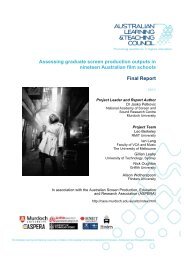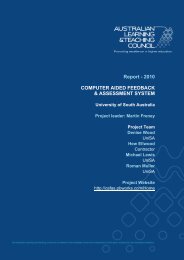Download Document - Office for Learning and Teaching
Download Document - Office for Learning and Teaching
Download Document - Office for Learning and Teaching
You also want an ePaper? Increase the reach of your titles
YUMPU automatically turns print PDFs into web optimized ePapers that Google loves.
6 FindingsThis section will present the main findings from our survey <strong>and</strong> interview analysis. Itconsists of four parts. Firstly, we compare the responses to each question by local<strong>and</strong> international students; we then look at the different perspectives on teaching<strong>and</strong> learning between international students <strong>and</strong> lecturers. As the majority of ourstudent participants are majoring in either IT or Business, we believe it isappropriate to look at the differences between IT <strong>and</strong> Business students in theirlearning experience. At the conclusion of our findings, we will discuss the difficultiesfaced by international students of Asian background when studying at Australianuniversities.Based on the survey <strong>and</strong> interview data collected, our study found that internationalstudents experience significant cross-cultural <strong>and</strong> language difficulties in theirlearning process.Their cross-cultural learning difficulties manifest in the following ways:- The teaching methods used in Australian universities, specifically in classroominteraction <strong>and</strong> face-to-face teaching, are significantly different from those usedin Asian countries. Open questions show that some 53% of internationalundergraduate students <strong>and</strong> 57.87% of international postgraduate studentsindicated that the main difference between the universities in their home country<strong>and</strong> Australia is in the teaching methods. These students have difficulty in readilyaccepting Australian teaching methods, particularly in their first year at Australianuniversities. Many of them prefer more face-to-face teaching <strong>and</strong> fewer studentquestions or class discussions during lectures. Some Asian students consider itto be a mark of appreciation <strong>and</strong> respect <strong>for</strong> their teachers <strong>for</strong> students to listenattentively <strong>and</strong> quietly in class. They consider that all discussion should takeplace after classes as any discussion will impinge on the teacher’s lecture time,resulting in reduced knowledge transmission to students, with the consequencethat students will learn less.- In their approach to learning, many students of Asian background dislike insistingon their own opinions when they conflict with those of the teacher. Theysometimes have difficulty or don’t like asking questions to their lecturers directlyin class. These issues result largely from the students’ cultural background. Insome Asian countries, teachers ask questions in class to check students’underst<strong>and</strong>ing of the content they are teaching, rather than encouraging criticalthinking. This is the main reason why students of Asian background ask fewerquestions in class.- Students from different cultural backgrounds have different attitudes to working ingroups. Our data shows that Asian students have a similar level of participationin group work <strong>and</strong> group assignments as non-Asian students, but are less likelyto offer different ideas because they value group harmony <strong>and</strong> respect <strong>for</strong>authority without argument. However, they often work as a team after classes tohelp each other <strong>and</strong> share their underst<strong>and</strong>ing of the subjects they have coveredin their daily study.- The learning methods used in Australian schools are significantly different fromthose used in their Asian counterparts. The survey results show that Asianundergraduate students rely more on rote learning <strong>and</strong> memorisation thanpostgraduates. In contrast, postgraduate students participate more in a variety ofteam work <strong>and</strong> experience better academic achievement. Indian students, whoconstitute one of the biggest international student communities, generally havebetter English skills than students from other Asian countries. They prefer anindirect communication style, whereas Chinese students prefer a capabilities-97
















